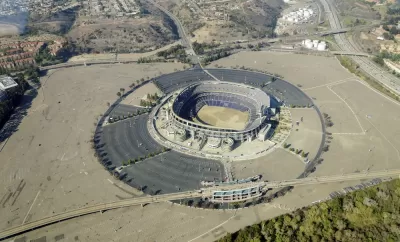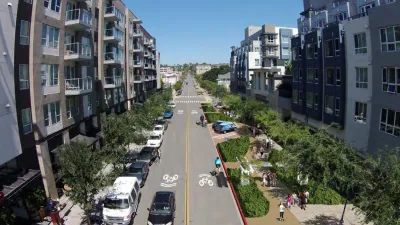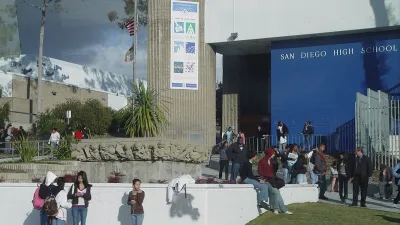For San Diego's Mission Valley Qualcomm Stadium site, AIA-SD and E+DC urge a structured and orderly planning and disposition process.

San Diego is experiencing "déjà vu all over again" (to quote Yogi Berra). Only a short while after saying no to the Charger's ultimatum of $2 billion or LA-exit, a new "investor group" has come up with a development proposal for the 166 acres of city owned land, which is occupied by the Chargers former home, Qualcomm Stadium. The proposal is named "Soccer City." This time it's a professional soccer fueled proposal making a grab for public assets—although at least this time it is allegedly for fair market value (after various asserted offsets). Under the proposal, Qualcomm stadium will be torn down and replaced with a new smaller stadium and surrounded with mixed-use development and open space. The investor group is pushing a sense of urgency in order to land a Major League Soccer franchise. An MLS committee is currently reviewing proposals from 12 cities for 4 expansion teams. Having stadium financing in place is a prerequisite for selection. The Soccer City proposal, with the usual allotment of tantalizing renderings, promises a 25 acre "sports and entertainment" district, including a 30,000 seat stadium billed as the "steepest in America," and "55 acres of green space," including a river park (yes, San Diego has a "river"), 5,000 residential units, and two hotels. The stadium is proposed to host both a new MLS team and San Diego State University's Aztecs football team, although the University has yet to sign on as a supporter and has voiced concerns about the stadium's capacity.
The San Diego chapter of the American Institute of Architects (AIASD) and the Environment + Design Council (E+DC) have written an open letter to the city's Mayor and City Council. The AIASD and E+DC are less concerned with the content of the proposal than the process to get there. The letter urges a thoughtful, open, and competitive process, stating:
[T]he AIASD and the E+DC urge the Mayor and City Council to follow a structured and orderly planning and disposition process, and to remember that, when the public is not involved in such a process up front and in a way that builds trust and confidence, the public and their attorneys will most assuredly protest and cause untimely years in court, be subject to referendums, and generally cause controversy and chaos. Following a structured process assures the public interest is best served, the City is better assured of doing the right thing for the land and our citizens, and it also reduces the potential for legal challenges by critics of whatever action the City takes. Our organizations believe that the public interest is best served by a competitive selection process using a Request for Qualifications (RFQ) or Request for Proposal (RFP) that allows for weighted criteria to evaluate developer qualifications and alternative proposals. The Qualcomm site is an extremely valuable regional asset, both economically and socially, and its redevelopment should be based upon a clear understanding and articulation of both community and regional benefits.
Before even getting to a RFQ and RFP though, the groups recommend:
[T]hat a citizen advisory commission be promptly appointed to develop a strong civic vision for the site, establish a framework plan based on that vision, identify selection criteria for the RFQ/RFP, assist the City in managing the selection process, and guide the implementation of the selected development proposal.
Renderings of the Soccer City proposal can be found on the developer's website "gallery." For the full letter, see it at the source article.
FULL STORY: AIA-SD and E+DC open letter regarding the Soccer City proposal for the Qualcomm Stadium site

Alabama: Trump Terminates Settlements for Black Communities Harmed By Raw Sewage
Trump deemed the landmark civil rights agreement “illegal DEI and environmental justice policy.”

Planetizen Federal Action Tracker
A weekly monitor of how Trump’s orders and actions are impacting planners and planning in America.

The 120 Year Old Tiny Home Villages That Sheltered San Francisco’s Earthquake Refugees
More than a century ago, San Francisco mobilized to house thousands of residents displaced by the 1906 earthquake. Could their strategy offer a model for the present?

Indy Neighborhood Group Builds Temporary Multi-Use Path
Community members, aided in part by funding from the city, repurposed a vehicle lane to create a protected bike and pedestrian path for the summer season.

Congestion Pricing Drops Holland Tunnel Delays by 65 Percent
New York City’s contentious tolling program has yielded improved traffic and roughly $100 million in revenue for the MTA.

In Both Crashes and Crime, Public Transportation is Far Safer than Driving
Contrary to popular assumptions, public transportation has far lower crash and crime rates than automobile travel. For safer communities, improve and encourage transit travel.
Urban Design for Planners 1: Software Tools
This six-course series explores essential urban design concepts using open source software and equips planners with the tools they need to participate fully in the urban design process.
Planning for Universal Design
Learn the tools for implementing Universal Design in planning regulations.
Clanton & Associates, Inc.
Jessamine County Fiscal Court
Institute for Housing and Urban Development Studies (IHS)
City of Grandview
Harvard GSD Executive Education
Toledo-Lucas County Plan Commissions
Salt Lake City
NYU Wagner Graduate School of Public Service





























